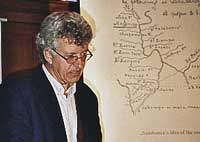Achim
von Oppen :
Moving along, moving
across. Linear geographies and translocal practices in an Angolan borderland
(Upper Zambezi, 19th to 20th century)
 |
This
contribution is about popular ways of conceptualizing space in the modern
history of the upper reaches of the Zambezi river, an area which is
now situated around the border between Angola and Zambia. It is an area
in which due to the scarcity of population and the abundance of modestly
fertile land, movement rather than boundary-making are the main practices
in which the inhabitants structure their everyday geographies. According
to their "mental maps", settlements and communications, social
ties and political relations were and to some extent still are structured
in linear, partly in concentric, but hardly in territorial terms. Watercourses,
today also roads, are the most important axes that provide ((läßt
sich das 2 Mal provide noch vermeiden?)) orientation and define proximity
and distance in both spatial and socio-political terms. The paper first
presents a reconstruction of these popular geographies for the late
pre-colonial period, based on an analysis of locational terminology,
written and oral narratives, field observations and early cartography.
It then goes on to explore the clashes and interactions of these conceptualizations
of space with the heavy-handed but often illusionary attempts by the
colonial state, mainly using evidence from the British side, to impose
a territorial order of things from the "international" down
to the very local level. What will emerge is a history not only of mutual
subversion of spatial concepts but also of mutual appropriation. This
tendency was facilitated by the utterly peripheral position of this
fim do mundo vis-a-vis the new central states on both sides, while hardly
impeding mobility in the region. |

